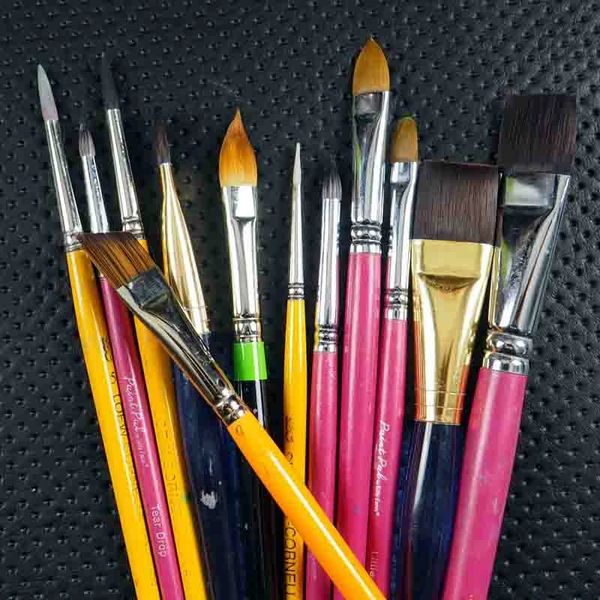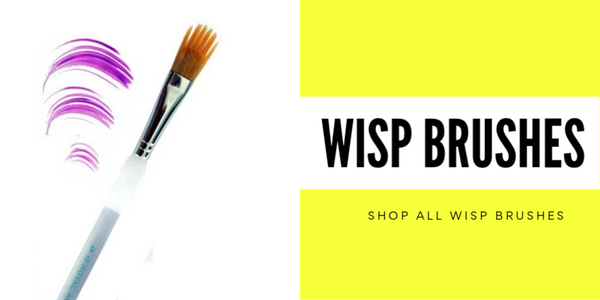
One equipment choice new face painters must make is which brushes they will need, not only in brand, but also in type of brush. Generally speaking, high quality brushes will produce better results than those of inferior quality, but in addition to this, each type of brush has peculiar traits which help it do certain tasks particularly well. As Marcela Murad recommends, you should be able to do every stroke with every brush, and this will require practice, but it’s also good to understand which brushes excel at which jobs so you purchase the ones you need and have them on hand so you can paint efficiently.
The Long and The Short of it
Artist brushes come in different styles and sizes, but for face painting purposes, you’ll probably find the short-handled brushes better because they take up less room in a kit. Normally the longer handled brushes are used to provide balance for artists who work while standing in front of an easel. The shorter handled brushes are usually used by artists who sit at a table with the work closer to them. I find that for face painting, I prefer the shorter handles.
Animal Hair vs. Synthetics
The most common bristles range from those made from various animal hairs (everything from hog to sable) to those which are synthetic (nylon or polyester). I prefer synthetic bristles because the good ones are durable, keep a nice point (depending on brand), have a good spring to them, and are affordable. I do own animal hair brushes, such as sable, but I reserve those exclusively for watercolor painting. The pointed rounds made of animal hair, like sable, keep an excellent point while painting, but for face painting I feel good quality synthetic bristle brushes can also give a good point.
Acrylic vs. Wooden Handles
Either wooden or acrylic handles work well, and I have both, but keep in mind that wooden handles can swell in water, and sometimes you’ll experience cracking in the finish on the handles when this happens. I correct this problem after I see cracks by allowing the brush to dry out completely and then applying a coat or two of polyurethane to the handle above the ferule, but by laying brushes flat while using them and not allowing them to stand in water (which is bad for them anyway), you’re less likely to experience the cracking in a brush.
Types of Brushes
Each artist has his or her favorite brushes, and as you try out the various kinds of brushes, you’ll find the ones which work best for you.
Round Brush and Pointed Round Brush
The round brush is an excellent choice for tear drops, swirls, and flower petals, but it can also be used to fill in small areas quickly. Round brushes come in a variety of sizes, and it’s a good idea to have a few of them in each size ranging from #1 to #6. My most used sizes are the #1, #2, #4, and #5.
If you like designs with bold teardrop shapes, you may want to invest in a few #8, #10, or #12 round brushes. I have a few of these as well, although I don’t use them as often.
Liner, Rigger, or Script Brush
The liner, also known as a rigger or script brush, has a long, slender bristle area. It comes in various sizes, and the one I use most is a #2 or #3. The advantage of a liner is that it holds more paint, so you don’t have to load as frequently while creating lines. I use the liner for outlining masks or dragons. Again, I keep three of these so I have one for white, one for black, and one for any other color I may need. Liners produce best results with wax-based paints, which tend to flow easily and thinly from the brush.
Flat and Bright
Two of the main workhorses for a face painter are the flat and the bright brush. They are able to cover large areas quickly, and are much more efficient for this task than round brushes. They’re also great for one-stroke painting. Since speed is important to a face painter, you should have a good variety of these brushes. They are similar except that the bright has shorter bristles so that the length of the bristles is about equal to the width of the brush. My large flat face painting brushes are brights. Those which measure 1/2-inch or smaller are flats. For this post, I’ll refer to both of them as flats. My most used flat brushes are the 1-inch, the 3/4-inch, and the 1/2-inch. (I rarely use a 1/4-inch flat brush or smaller and don’t usually carry them in my kit.)
For one-stroke designs, I keep several 1-inch or 3/4-inch flats on hand, reserving one for each of the most used one-stroke split cakes I use. This speeds work up during events during when I need to be fast, and if speed is important to you, you need to acquire several of these brushes.
At least two or three of the 1/2-inch flat brushes is preferred. I use these in a one-stroke capacity for leaves and dragons or for quick coverage of large areas.
You might notice a bright referred to as a chisel bright or a chisel blender from some art suppliers. This is because the bristles taper off in length on either side of the brush as they approach the very tip of the brush, meaning they hold less paint and therefore can be used more easily for blending. Other brushes may also be made in this way, but because of it, you can pull the brush to the side and create a slender line with the tip of the bristles.
Filbert and Double Filbert
Another popular brush which you should have on hand is the filbert. The filbert is like a flat brush, but the tip of the bristles is curved rather than straight across. This makes it great for curved edges. A double filbert has two rounded portions on the end which are side by side, making it good for flower petals. Long bristled filberts are called egberts.
Some face painters use their filbert brushes more than their flat brushes. Again, you should have several sizes of filberts, ranging from 3/4-inch (or 1-inch) to 1/4-inch. My most used filbert is the 1/2-inch size or 1/4-inch size, but your usage preferences will depend on what type of designs you do most. Margi Kanter, whose style makes use of beautifully organic shapes and ranges from humorous cartoons to bold swirls and teardrops, often uses filberts for filling in areas of color in a design.
The bristles on a filbert also tend to taper off in length as they approach the rounded edge of the brush, so some artists refer to them as chisels, but other brush shapes (such as the bright) can also have bristles which taper off in a chisel fashion. The term chisel really just describes the way the bristles are set in the brush, not what type of brush it is. (Keep in mind that this is consistent with the fine art brush definition, but not the makeup brush definition. Chisel brushes for applying regular makeup look different.)
If you do an internet search for chisel brush, you’ll come up with a wide variety of brushes which don’t look anything alike. However, in the face painting world, artists referring to a chisel brush sometimes mean a brush with shortish bristles which taper and have a rounded edge like a filbert.
Angle Brush
The angle brush is like the flat brush, but the bristles are cut at an angle so they are shorter on one side and longer on the other. Although I rarely use the angle brush, it is a great favorite for many face painters, especially in the size of 3/4-inch or 1/2-inch brushes, and is often used for making one-stroke roses, leaves, and butterflies.
Dagger Brush
The angle of a dagger brush is much more acute than that of an angle brush. It has a beautiful point which makes excellent whiskers.
Fan Brush
The fan brush (made iconic by artist Bill Alexander), is a brush which is shaped like a fan. The bristles are placed thinly in the ferule, and it gives a distinctive wispy effect when used for painting. The fan brush excels at the look of fur. I don’t use my fan brush much, but I do carry one with me.
Wisp Brush
The wisp brush can take the basic form of a flat brush, angle brush, filbert, or fan, but some of the bristles have been trimmed short at intervals, allowing it to make several parallel lines at once when the loaded brush is dragged across a surface. Wisp brushes can add interesting and delicate effects to a design, so it’s worth experimenting with to see if it’s a good choice for you.
Standard Makeup Brushes

And of course, you can use standard makeup brushes for applying paint. One of my favorites is the Royal and Langnickel Moda Pro Sculpt Brush. It's effecting when you need to put down a beautiful, even layer of color over large area.
I hope this post has helped you to become acquainted with many of the basic brushes you’ll need as a face painter, and that that your shopping decisions will be easier as you search for the brushes which work best for you as an artist. Happy painting!
______
Beth MacKinney is the owner of and primary face painter for Face Paint Pizzazz in the NW Chicago suburbs. Stop by Clownantics.com to see other tutorials and blog posts she has written for face painters.
 FREE SHIPPING FOR USA ORDERS OVER $100
FREE SHIPPING FOR USA ORDERS OVER $100

















Beth MacKinney
April 22, 2020
Thanks for your comment, Nicole. Some artists do prefer using the standard makeup brushes for face painting. Among other standard makeup brushes, we carry the Royal and Langnickel Moda Pro Sculpt Brush, which is excellent for putting down beautifully even layers of color on the face. I think it is especially good for designs such as sugar skulls, where you want a delicate, even layer of white which is not too heavy, but it’s great for anything for which you want to cover a large area quickly with a color.